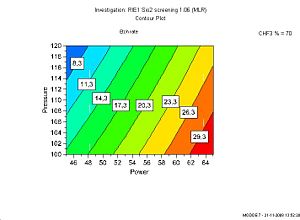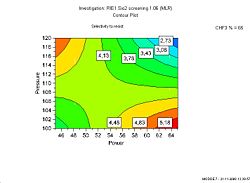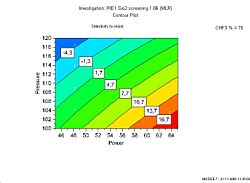Specific Process Knowledge/Etch/Etching of Silicon Oxide/SiO2 etch using RIE1 or RIE2: Difference between revisions
No edit summary |
|||
| (17 intermediate revisions by the same user not shown) | |||
| Line 1: | Line 1: | ||
'''Feedback to this page''': '''[mailto:labadviser@ | '''Feedback to this page''': '''[mailto:labadviser@nanolab.dtu.dk?Subject=Feed%20back%20from%20page%20http://labadviser.nanolab.dtu.dk/index.php/Specific_Process_Knowledge/Etch/Etching_of_Silicon_Oxide/SiO2_etch_using_RIE1_or_RIE2 click here]''' <br> | ||
{{CC-bghe1}} <br> | |||
=<span style="color:#FF0000"> Both RIE's (RIE1 and RIE2) for silicon based etching has been decommissioned </span> = | |||
RIE (Reactive Ion Etch) can be used for etching silicon oxide. The etch is anisotropic with vertical or angled sidewalls depending on the process recipe and the masking material and geometry. The SiO<sub>2</sub> is etched by flour radicals assisted by ion bombardment. | RIE (Reactive Ion Etch) can be used for etching silicon oxide. The etch is anisotropic with vertical or angled sidewalls depending on the process recipe and the masking material and geometry. The SiO<sub>2</sub> is etched by flour radicals assisted by ion bombardment. | ||
==The substrate:== | ==The substrate:== | ||
Must be a wafer of 4" or below or small pieces, not higher than about 2mm. The system can be set up for 6", please ask 2 weeks in advance. | |||
==The silicon can be masked by these materials:== | ==The silicon can be masked by these materials:== | ||
| Line 13: | Line 14: | ||
*Silicon Nitride | *Silicon Nitride | ||
*Aluminium | *Aluminium | ||
*Other metals if they cover less than 5% of the wafer area. | |||
*Other metals if they cover less than 5% of the wafer area | |||
==Most used recipes:== | ==Most used recipes:== | ||
===QC results=== | ===QC results=== | ||
{| border="1" cellspacing="2" cellpadding="2" colspan="3" | {| border="1" cellspacing="2" cellpadding="2" colspan="3" | ||
|bgcolor="#98FB98" |'''Quality Controle (QC) for | |bgcolor="#98FB98" |'''Quality Controle (QC) for RIE2 - oxide etch''' | ||
|- | |- | ||
| | | | ||
*[http://labmanager.danchip.dtu.dk/d4Show.php?id=1389&mach=18 The QC procedure for | *[http://labmanager.danchip.dtu.dk/d4Show.php?id=1389&mach=18 The QC procedure for RIE2]<br> | ||
*[http://www.labmanager.danchip.dtu.dk/view_binary.php?type=data&mach=19 The newest QC data for RIE2] | *[http://www.labmanager.danchip.dtu.dk/view_binary.php?type=data&mach=19 The newest QC data for RIE2] | ||
{| {{table}} | {| {{table}} | ||
| Line 33: | Line 32: | ||
|- | |- | ||
| CF<sub>4</sub> flow | | CF<sub>4</sub> flow | ||
| sccm | | 14 sccm | ||
|- | |- | ||
|CHF<sub>3</sub> flow | |CHF<sub>3</sub> flow | ||
| sccm | | 26 sccm | ||
|- | |- | ||
|Pressure | |Pressure | ||
| | |100 mTorr | ||
|- | |- | ||
|RF-power | |RF-power | ||
| Line 51: | Line 50: | ||
{| border="2" cellspacing="1" cellpadding="2" align="center" style="width:500px" | {| border="2" cellspacing="1" cellpadding="2" align="center" style="width:500px" | ||
!QC limits | !QC limits | ||
!RIE2 | !RIE2 | ||
|- | |- | ||
|Etch rate in Si | |Etch rate in Si | ||
| | |6 - 17 nm/min | ||
|- | |- | ||
|Non-uniformity | |Non-uniformity | ||
| | |<±13.5% | ||
|- | |- | ||
|} | |} | ||
| Line 91: | Line 87: | ||
{| border="2" cellspacing="1" cellpadding="3" align="center" | {| border="2" cellspacing="1" cellpadding="3" align="center" | ||
! | ! | ||
!Expected results in RIE1 | !Expected results in RIE1 (has been decommissioned) | ||
!Expected results in RIE2 | !Expected results in RIE2 | ||
|- | |- | ||
|Etch rate in SiO<sub>2</sub> | |Etch rate in SiO<sub>2</sub> | ||
|~20-30 nm/min | |style="background:WhiteSmoke; color:silver"| | ||
~20-30 nm/min | |||
|~20-30 nm/min | |~20-30 nm/min | ||
|- | |- | ||
| Line 103: | Line 100: | ||
|- | |- | ||
|Etch rate in P-Si (when used as mask) | |Etch rate in P-Si (when used as mask) | ||
|~30 nm/min | |style="background:WhiteSmoke; color:silver"| | ||
~30 nm/min | |||
|~30 nm/min | |~30 nm/min | ||
|- | |- | ||
|Etch rate in Si | |Etch rate in Si | ||
(etching down to Si) | (etching down to Si) | ||
|Expected <2 nm/min | |style="background:WhiteSmoke; color:silver"| | ||
Expected <2 nm/min | |||
|Expected <2 nm/min | |Expected <2 nm/min | ||
|- | |- | ||
| Line 138: | Line 137: | ||
{| border="2" cellspacing="1" cellpadding="3" align="center" | {| border="2" cellspacing="1" cellpadding="3" align="center" | ||
! | ! | ||
!Expected results in RIE1 | !Expected results in RIE1 (HAS BEEN DECOMMISSIONED) | ||
!Expected results in RIE2 | !Expected results in RIE2 | ||
|- | |- | ||
|Etch rate in SiO<sub>2</sub> | |Etch rate in SiO<sub>2</sub> | ||
|~70-80 nm/min | |style="background:WhiteSmoke; color:silver"| | ||
~70-80 nm/min | |||
|~70-80 nm/min | |~70-80 nm/min | ||
|- | |- | ||
| Line 150: | Line 150: | ||
|- | |- | ||
|Etch rate in P-Si (when used as mask) | |Etch rate in P-Si (when used as mask) | ||
|~20-30 nm/min | |style="background:WhiteSmoke; color:silver"| | ||
~20-30 nm/min | |||
|~20-30 nm/min | |~20-30 nm/min | ||
|- | |- | ||
| Line 159: | Line 160: | ||
|- | |- | ||
|Images | |Images | ||
|[[/Images of 1SiO2mSi with p-Si mask|Etches with p-Si as masking material]] | |style="background:WhiteSmoke; color:silver"| | ||
[[/Images of 1SiO2mSi with p-Si mask|Etches with p-Si as masking material]] | |||
|[[/Images of 1SiO2mSi with p-Si mask|Etches with p-Si as masking material]] | |[[/Images of 1SiO2mSi with p-Si mask|Etches with p-Si as masking material]] | ||
|- | |- | ||
| Line 188: | Line 190: | ||
{| border="2" cellspacing="1" cellpadding="3" align="center" | {| border="2" cellspacing="1" cellpadding="3" align="center" | ||
! | ! | ||
!Expected results in RIE1 | !Expected results in RIE1 (HAS BEEN DECOMMISSIONED) | ||
!Expected results in RIE2 | !Expected results in RIE2 | ||
|- | |- | ||
|Etch rate in SiO<sub>2</sub> | |Etch rate in SiO<sub>2</sub> | ||
|~120 nm/min | |style="background:WhiteSmoke; color:silver"| | ||
~120 nm/min | |||
|~120 nm/min | |~120 nm/min | ||
|- | |- | ||
|Etch rate burned resist | |Etch rate burned resist | ||
|? | |style="background:WhiteSmoke; color:silver"| | ||
? | |||
|? | |? | ||
|- | |- | ||
|Etch rate in Si<sub>3</sub>N<sub>4</sub> | |Etch rate in Si<sub>3</sub>N<sub>4</sub> | ||
|? | |style="background:WhiteSmoke; color:silver"| | ||
? | |||
|? | |? | ||
|- | |- | ||
|Etch rate in P-Si (when used as mask) | |Etch rate in P-Si (when used as mask) | ||
|? nm/min | |style="background:WhiteSmoke; color:silver"| | ||
? nm/min | |||
|? nm/min | |? nm/min | ||
|- | |- | ||
|Etch rate in Si | |Etch rate in Si | ||
(etching down to Si) | (etching down to Si) | ||
|? | |style="background:WhiteSmoke; color:silver"| | ||
? | |||
|? | |? | ||
|- | |- | ||
|Images | |Images | ||
|[[/Images of 1SIO2mbr with p-Si mask|Etches with p-Si as masking material]] | |style="background:WhiteSmoke; color:silver"| | ||
[[/Images of 1SIO2mbr with p-Si mask|Etches with p-Si as masking material]] | |||
[[/Images of 1SIO2mbr with burned resist mask|Etches with burned resist as masking material]] | [[/Images of 1SIO2mbr with burned resist mask|Etches with burned resist as masking material]] | ||
|[[/Images of 1SIO2mbr with burned resist mask|Etches with burned resist as masking material]] | |[[/Images of 1SIO2mbr with burned resist mask|Etches with burned resist as masking material]] | ||
| Line 223: | Line 231: | ||
A DOE has been performed. A short summery is given here: (in progress) | A DOE has been performed. A short summery is given here: (in progress) | ||
===RIE1:=== | ===RIE1: RIE1 has been decommissioned but the results are probably similar on RIE2=== | ||
A Design Of Experiment (DOE) has been performed. A screening experiment: full factorial with to levels: 9 different runs and 3 repetitions. Results from a screening experiment should be taken "with a gain of salt" meaning use it only as a rough guide line and test your recipe before use. | A Design Of Experiment (DOE) has been performed. A screening experiment: full factorial with to levels: 9 different runs and 3 repetitions. Results from a screening experiment should be taken "with a gain of salt" meaning use it only as a rough guide line and test your recipe before use. | ||
Latest revision as of 15:18, 6 February 2023
Feedback to this page: click here
This page is written by Berit Herstrøm @ DTU Nanolab (BGHE) if nothing else is stated
Both RIE's (RIE1 and RIE2) for silicon based etching has been decommissioned
RIE (Reactive Ion Etch) can be used for etching silicon oxide. The etch is anisotropic with vertical or angled sidewalls depending on the process recipe and the masking material and geometry. The SiO2 is etched by flour radicals assisted by ion bombardment.
The substrate:
Must be a wafer of 4" or below or small pieces, not higher than about 2mm. The system can be set up for 6", please ask 2 weeks in advance.
The silicon can be masked by these materials:
- Photoresist
- E-beam resist
- Silicon
- Silicon Nitride
- Aluminium
- Other metals if they cover less than 5% of the wafer area.
Most used recipes:
QC results
| Quality Controle (QC) for RIE2 - oxide etch | ||||||||||||||||||||
|
Resist as masking material:
| Recipe: | 1SiO2mre |
|---|---|
| Masking material | Photoresist |
| CF4 flow | 14 sccm |
| CHF3 flow | 26 sccm |
| Pressure | 100 mTorr |
| RF-power | 60 W |
| Expected results in RIE1 (has been decommissioned) | Expected results in RIE2 | |
|---|---|---|
| Etch rate in SiO2 |
~20-30 nm/min |
~20-30 nm/min |
| Etch rate in Si3N4 | ? | ? |
| Etch rate in P-Si (when used as mask) |
~30 nm/min |
~30 nm/min |
| Etch rate in Si
(etching down to Si) |
Expected <2 nm/min |
Expected <2 nm/min |
mre:mask resist
PolySilicon as masking material
| Recipe: | 1SiO2msi |
|---|---|
| Masking material | Silicon |
| CF4 flow | 8 sccm |
| CHF3 flow | 40 sccm |
| Pressure | 150 mTorr |
| RF-power | 150 W |
| Expected results in RIE1 (HAS BEEN DECOMMISSIONED) | Expected results in RIE2 | |
|---|---|---|
| Etch rate in SiO2 |
~70-80 nm/min |
~70-80 nm/min |
| Etch rate in Si3N4 | ? | ? |
| Etch rate in P-Si (when used as mask) |
~20-30 nm/min |
~20-30 nm/min |
| Etch rate in Si
(etching down to Si) |
? | ? |
| Images | Etches with p-Si as masking material |
msi:mask silicon
The recipe: 1SiO2bre (se below) can also be used with p-Si as masking material.
Burned resist as masking material (developed for waveguides by Haiyan Ou @DTU Photonics):
| Recipe: | 1SiO2mbr |
|---|---|
| Masking material | Burned resist (250oC 1h) |
| CHF3 flow | 84 sccm |
| Pressure | 60 mTorr |
| RF-power | 200 W |
| Expected results in RIE1 (HAS BEEN DECOMMISSIONED) | Expected results in RIE2 | |
|---|---|---|
| Etch rate in SiO2 |
~120 nm/min |
~120 nm/min |
| Etch rate burned resist |
? |
? |
| Etch rate in Si3N4 |
? |
? |
| Etch rate in P-Si (when used as mask) |
? nm/min |
? nm/min |
| Etch rate in Si
(etching down to Si) |
? |
? |
| Images |
Etches with p-Si as masking material Etches with burned resist as masking material |
Etches with burned resist as masking material |
mbr:mask burned resist
A survey of the parameter space using photoresist as masking material
A DOE has been performed. A short summery is given here: (in progress)
RIE1: RIE1 has been decommissioned but the results are probably similar on RIE2
A Design Of Experiment (DOE) has been performed. A screening experiment: full factorial with to levels: 9 different runs and 3 repetitions. Results from a screening experiment should be taken "with a gain of salt" meaning use it only as a rough guide line and test your recipe before use.
|
The Design of the experiment
|
Etch rate |
|---|
Selectivity to photoresist
|
|
|---|
Etch profile angle <br\> The etch profile was also examined but there was not found any significant correlation between the profile angle and the process parameters.



